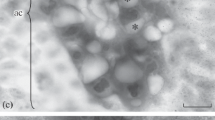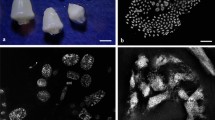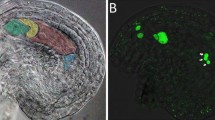Abstract
Dynamics of an antipodal complex formation in wheat (Tritiñum aestivum L.) has been observed in detail using a reconstruction of serial semifine sections. Three consecutive crucial stages have been identified in the development of the antipodal complex: (1) proliferation of initial cells, (2) growth and functional differentiation of antipodal cells, and (3) cell apoptosis. Specific features of the mitotic division of antipodal cells have been characterized. It has been shown that the structure of interphase nuclei and mitotic chromosomes of proliferating antipodal cells is similar to that of nucellar cells surrounding the embryo sac. According to the reconstruction of appropriately oriented serial sections, the division of antipodal cells is asynchronous. DNA content in differentiated antipodal cells has been determined by a cytophotometric analysis; in the case of a mature embryo sac, the ploidy of antipodal cells varied from 8 to 32C. Proliferation and DNA endoreduplication processes in the antipodal complex proceed at different time; the second process starts only after the termination of the first one. DNA endoreduplication is accompanied by total chromatin remodeling; as a result, giant chromosomes are formed in the nuclei of antipodal cells. The final stage of the antipodal complex development is programmed cell death or apoptosis. A model for the structural organization of an antipodal complex has been proposed based on the layer arrangement of cells. The secretory activity of antipodal cells directed towards the endosperm syncytium has been detected for the first time. The analysis of “truncated” ovules with an undeveloped endosperm has shown that developing endosperm can be a possible inductor, which stimulates the functional activity of antipodal cells and triggers their terminal differentiation. The obtained results evidence the functional role of antipodal cells in the development of the endosperm and embryo.
Similar content being viewed by others
References
Batygina, T.B., Embriologiya pshenitsy (Wheat Embryology), Leningrad: Kolos, 1974.
Bhatnagar, S.P. and Chandra, S., Reproductive Biology of Triticum. III, Phytomorphology, vol. 25, no. 4, pp. 471–477.
Brink, R.A. and Cooper, D.C., The Antipodal in Relation to Abnormal Endosperm Behavior in Hordeum jubatum Secale Cereale Hybrid Seeds, Genetics, 1944, vol. 29, pp. 291–340.
Chaban, I.A., Genesis of the Antipodal Complex of Wheat Embryo Sac, in XII s’ezd RBO. Fundamental’nye i prikladnye problemy botaniki v nachale XXI veka. Materialy vserossiiskoi konferentsii (XII Congress of the Russial Botanical Society. “Fundamental and Applied Problems in Botany at the Beginning of the XXI Century”), Petrozavodsk, 2008, p. 302.
Cionini, P.G., Cavallini, A., Baroncelli, S., Lercari, B., D’Amato, F., Diploidy and Chromosome Endoreduplication in the Development of Epidermal Cell Lines in the First Foliage Leaf Durum Wheat Triticum durum Desf., Protoplasma, 1983, vol. 118, pp. 156–162.
Diboll A.G., Larson D.A. Fine Structural Development of the Megagametofite of Zea mays Following Fertilization, Am. J. Bot., 1966, vol. 55, no. 7, pp. 787–806.
Embriologiya tsvetkovykh rastenii. Terminologiya i kontseptsii (Embryology of Flowering Plants: Terminology and Concepts), Batygina, T.B., Ed., St. Petersburg: Mir i sem’ya, 1994.
Engell, K., Embryology of Barley. IV. Ultrastructure of the Antipodal Cells of Hordeum vulgare L. cv. Bomi before and after Fertilization of the Egg Cell, Sex Plant Reprod., 1994, vol. 7, pp. 333–348.
Ivanovskaya, E.V., Functional Morphology of Polytene Chromosomes of Wheat Antipode, Tsitologiia, 1973, vol. 15, no. 12, pp. 1445–1452.
Kaufmann, B.P., Gay, H., and McDonald, M.R., Organizational Patterns within Chromosomes, Int. Rev. Cytol., 1960, vol. 9, pp. 77–127.
Lazareva, E.M. and Chentsov, Yu.S., Localization of Fibrillarin, 53 kDa Protein and AgNOR Proteins in the Nuclei of Giant Antipodal Cells of the Wheat Triticum aestivum, Tsitologiia, 2004, vol. 46, no. 2, pp. 125–135.
Li-Hua An and Rui-Lin You, Studies on Nuclear Degeneration during Programmed Cell Death of Synergid and Antipodal Cells in Triticum aestivum, Sex Plant Reprod., 2004, vol. 17, pp. 195–201.
Melaragno, J.E, Mehrotra, B., and Coleman, A.W., Relationship between Endopolyploidy and Cell Size in Epidermal Tissue of Arabidopsis, Plant Cell, 1993, vol. 5, pp. 1661–1668.
Otsuki, Y., Li, Z.L., and Shibata, V.F., Apoptotic Detection Methods: from Morphology to Gene, J. Prog. Histochem. Cytol., 2003, vol. 38, pp. 275–339.
Petrova, T.F., Method of Preparation of Total Embryological Preparations of the Endosperm, Botan. Zh., 1970, vol. 55, no. 11, pp. 1662–1665.
Petrova, T.F., Solov’yanova, O.B., and Chentsov, Yu.S., Ultrastructure of Giant Chromosomes in Barley Antipodal Cells, Tsitologiia, 1985, vol. 27, no. 5, pp. 499–502.
Poddubnaya-Arnol’di’, V.A., Tsitoembriologiya pokrytosemennykh rastenii. Osnovy i perspektivy (Cytoembryology of Angiosperms: Principles and Prospects), Moscow: Nauka, 1976.
Rigin, B.V. and Orlova, I.N., Pshenichno-rzhanye amfidiploidy (Wheat-Rye Amphidiploids), Leningrad: Kolos, 1974.
Tominaga, R., Iwata, M., Sano, R., Inoue, K., Okada, K., and Wada, T., Arabidopsis CAPRICE-LIKE MYB 3 (CPL3) Controls Endoreduplication and Flowering Development in Addition to Trichome and Root Hair Formation, Development, 2008, vol. 135, pp. 1335–1345.
Traas, J., Hülskamp, M., Gendreau, E., and Höfte, H., Endoreduplication and Development: Rule without Dividing?, Curr. Opin. Plant Biol., 1998, vol. 1, pp. 498–503.
You, R. and Jensen, W.A., Ultrastructural Observation of the Mature Megagametophyte and Fertilisation in Wheat Triticum aestivum L., Can J. Bot., 1985, vol. 63.
Zhimulev, I.F., Khromosomy. Struktura i funktsii (Chromosomes. Structure and Functions), Novosibirsk: Sib. Otd. Ross. Akad. Nauk, 2009.
Zhimulev, I.F., Morphology and Structure of Polytene Chromosomes, Adv. Genet., 1996, vol. 34, pp. 1–359.
Author information
Authors and Affiliations
Corresponding author
Additional information
Original Russian Text © I.A. Chaban, E.M. Lazareva, N.V. Kononenko, V.Yu. Polyakov, 2011, published in Ontogenez, 2011, Vol. 42, No. 2, pp. 101–115.
Rights and permissions
About this article
Cite this article
Chaban, I.A., Lazareva, E.M., Kononenko, N.V. et al. Antipodal complex development in the embryo sac of wheat. Russ J Dev Biol 42, 79–91 (2011). https://doi.org/10.1134/S1062360411010048
Received:
Accepted:
Published:
Issue Date:
DOI: https://doi.org/10.1134/S1062360411010048




